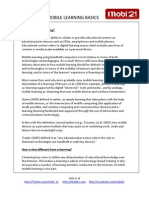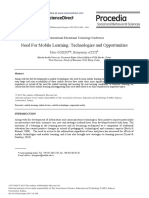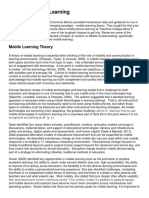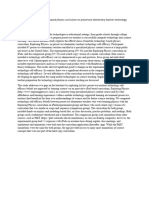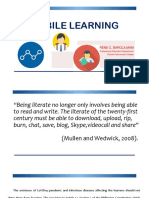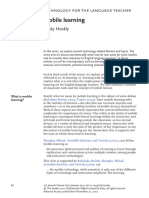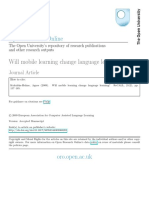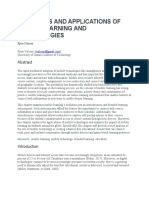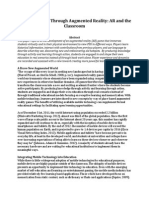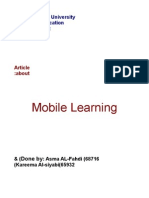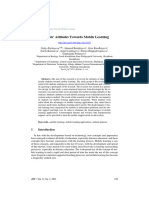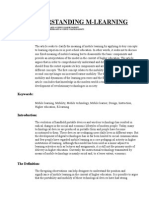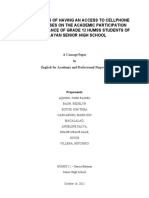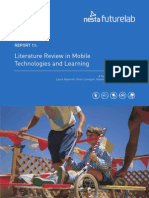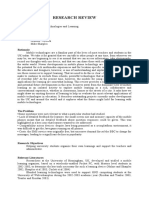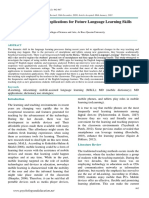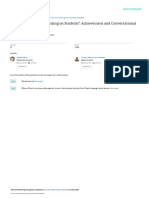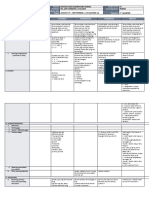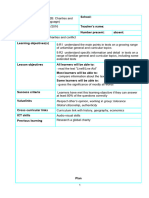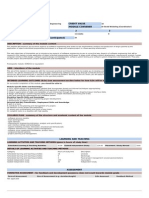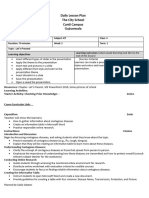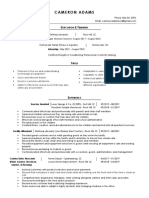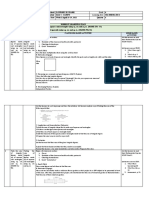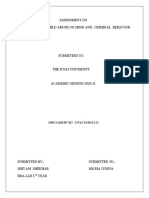THE UNIVERSITY OF EDENBURG
GLENWOOD CAMPUS
NAME: ABIGAIL NALUNGWE
STUDENT ID: 20122597
PROGRAM: SECONDARY TEACHERS DEGREE IN MATHEMATICS
COURSE: ED 322 CURRICULUM THEORY AND PRACTICE
LECTURE: PROF. BANDA, M.
ASSIGNMENT NO: 3
DUE DATE: 25-08-2022
QUESTION:
Mobility enables learners to take their learning with them beyond the physical walls and
boundaries of learning institutions by use of mobile technologies such as cellular phones,
laptop computers and wireless networks (Kantini; Banda and Kabeta 2017). Using five
examples succinctly discuss this assertion.
1|Page
�Technology is now having an impact on teaching and learning. Mobile learning, which is
conducted with the use of mobile technologies such as cellular phones, laptop computers and
wireless networks is gaining ground. This is interesting to many educators because of the way
it is being imparted to the learners: education with no situated classroom, ignoring distance
and time. The learners can now have access to education and to a vast amount of knowledge
without much time and effort on both educators and learners. Hence learning mobility in
discourse.
It is a fact that things have become easy with the use of technology such as the Internet and
other Information Technology features, for example, software that make it easy for imparting
education and knowledge to learners. Ryu and Parsons, (2002) “The term ‘mobile’ as become
popular with the emergence of multiple hand-held technologies as it seems a necessity in
education.” On the other hand, in traditional education, knowledge, and information are
transmitted from teacher to learner, through the use of books, or hand-outs. In technology-
supported learning, education is imparted using web pages, computer-assisted learning
packages, or virtual learning environments.
Ryu and Parsons, (2002) added; “the concept of mobile learning promises users new and
advanced user experiences, which are quite often markedly different from those afforded by
conventional desktop computer-based learning systems.”
This means, “Being mobile as one learns or studies.” It is also revolutionary in the sense that
learning is not the ordinary teacher-student interaction in a traditional classroom, but the
students are away doing their other jobs or chores at home, or whatever, but still learning
through a connection with the Internet (Andronico et al., 2004).
This gives an advantage to mobile learning, (mobility) as students or those involved in
continuing education are given access to the vast knowledge and information through
databases and web libraries from a given website, not only that; Students can also conduct
online searches using the resources of the library or a scholarly Web site; Working through
problems using spreadsheet software. Others can take online quizzes. Conduct experiments in
virtual science labs. View online images and video clips and many more (Rainger, 2005).
With the above detailed information, it is bear that Mobile learning uses mobile phones,
smartphones, palmtops and handheld computers (PDAs), tablet PCs, laptop computers, and
2|Page
�personal media players. To facilitate learning, furthermore, a mobile learning educational
process can now be viewed as any learning and teaching activity that is possible through
mobile tools, or in settings where mobile equipment is made available (Andronico et al.,
2004).
An example of mobile learning is when learners, using third or fourth-generation (3G/4G)
mobile handsets, can access a multimedia-based English language learning tool supported by
location software services. This holds out the promise of unlimited access to educational
resources beyond the traditional institutional boundaries, amalgamating currently separated
learning activities into one with an integrated technology platform” (Ryu and Parsons, 2008).
According to Banda, (2003) argued that the use of mobile devices in the classroom affects the
academic performance due to the distraction it generates by its multitasking characteristic.
The main distractions are: access to social networks, text messages and multimedia content.
Mobile devices can be used as an effective learning tool because of their mobility and
approachability. Mobile devices are expected to be an effective learning tool and to be a part
of all learning activities, both outside and inside the classroom. In order to successfully adopt
mobile learning in the process of teaching and education, it is necessary to have more
information about the awareness and acceptance of mobile devices by students and
instructors as learning tools.
Ally, (2009) came on board with a different view on mobility, he stressed that mobile
learning, through the use of mobile technology, can allow access to “learning materials and
information from anywhere and at any time. Learners will not have to wait for a certain time
to learn or go to a certain place to learn. With mobile learning, learners will be empowered
since they can learn whenever and wherever they want”
Traxler, (2009) posits that while mobile-learning is recognized as an effective teaching
approach, educational institutions seeking to improve learning often derive poor results in the
use of this technology. This can be explained by the numerous obstacles in the school
organizational, individual, and technological levels faced by these institutions in the search
for mobile-learning initiatives. “Although mobile-learning has many advantages over
traditional modes of learning, its development is still new in education. It still has a number
of problems that must be addressed in order for it to reach its full potential,” he added.
3|Page
�The study also found that other community members and Zambian academics felt that ICTs
had a negative impact on human development in the schools. One civic leader said
“technology is good. But it’s killing our pupils and students. They do not read anymore but
reproduce internet stuff. In class you find them busy on Facebook and messaging each other.
Every day you have to punish some pupils because of phones, (Banda, 2003). Another
respondent, a Parent teacher’s association member said that “it’s not easy to control our
children now. While with you, they can be talking to their boyfriends and girlfriends. They’ll
finish ‘everything’ in your presence, (Banda, 2003).”
As perceived; mobile-learning may be incompatible with social and cultural norms. For
example, mobile devices can be perceived as sources of distraction, both by teachers and
students, which may affect academic achievement .Some educational institutions report that
the collaborative pedagogical use of mobile technology occurs to a limited extent and
learning face-to-face interaction with experts rarely occurs, this could be a threat that could
degrade their educational quality (Traxler, 2009).
Traxler, (2009) added, “It is evident that the acquisition of mobile-learning awakens students
to a negative expectation, because students feel that they need to make additional efforts to
master mobile-learning skills. These disadvantages, limitations and barriers create a
considerable degree of resistance to the adoption of mobile-learning in support of learning in
educational settings. As shown above, you can list the critical factors that must be addressed
or overcome for a correct adoption of mobile-learning.”
To crown it all, despite the limitations, disadvantages and cultural barriers, initiatives to
promote mobile-learning at every level of education are growing every day. The
breakthrough of technology and the current mobile device penetration indicate that in the
future, mobile learning will no longer be an option. The use of mobile devices to support
learning will be a necessity in a modern educational system. Currently, mobile-learning plays
an increasingly important role in the development of learning teaching methods in higher
education.
4|Page
�REFERENCES
Ally, M., (2009), ed. Mobile Learning. Canada: Athabasca University Press.
Andronico, A., et al., (2004.) Designing Models and Services for Learning Management
Systems in Mobile Settings., Germany: Springer-Verlag.
Banda, A. (2003). “Resurrecting UNZA.” The Post Newspaper, February 23rd, p. 13.
Rainger, P., (2005). Accessibility and Mobile Learning. InTraxler J.Eds. Mobile Learning:
A Handbook for Educators and Trainers. New York: Rutledge.
Ryu, H. and Parsons, D., (2008). Innovative Mobile Learning: Techniques and
Technologies.
United Kingdom: Information Science Reference,
Traxler, J., (2009). Current State of Mobile Learning. In Ally, M., 2009, ed. Mobile
Learning. Canada: Athabasca University Press
Trinder, J., (2005). Mobile Technologies and Systems. In Kukulska-Hulme, A &. p. 7
5|Page


